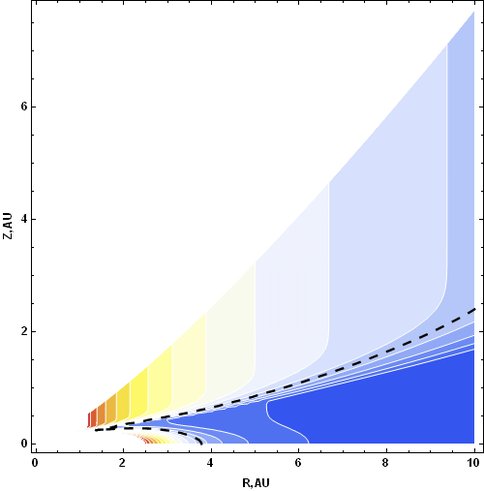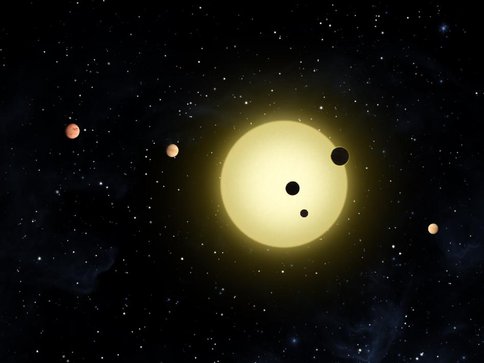2011 Annual Science Report
 NASA Ames Research Center
Reporting | SEP 2010 – AUG 2011
NASA Ames Research Center
Reporting | SEP 2010 – AUG 2011
Disks and the Origins of Planetary Systems
Project Summary
This task is concerned with understanding the evolution of complex habitable environments as primitive planetary bodies are forming in a developing protoplanetary disk. The planet formation process begins with the collapse of large molecular clouds into flattened disks. This disk is in many ways an astrochemical “primeval soup” in which cosmically abundant elements are assembled into increasingly complex hydrocarbons and mixed in the dust and gas envelope within the disk. Gravitational attraction among the myriad small bodies leads to planet formation. If the newly formed planet is a suitable distance from its star to support liquid water at the surface, it is in the so called “habitable zone.” The formation process and identification of such life-supporting bodies is the goal of this project.
Project Progress
Co-I D. Richard has continued to model the optical properties of non-spherical and/or inhomogeneous particles as analogs of realistic astrophysical dust grains. An application to the scattering of light by three classes of grains (aggregates, angular irregular and spherical with iron inclusions) has been published this year (Richard et al, 2011). These models show strong grain-shape and wavelength dependence in scattering and absorption efficiencies. These variations in optical properties are important in the treatment of the dust component in proto-planetary nebulae. Current models usually use Mie theory for spherical homogeneous grains to compute the opacity due to dust in disks. Our model shows large deviations from Mie prediction. The computation of opacity based on our results for individual grains is therefore expected to lead to significantly different values compared to current standard opacities.
Co-I S. Davis continues work on models of large scale transport in protoplanetary disks Davis has written a draft paper, now in review, on the location of water ice in the protoplanetary nebula using a new model that takes into account the evolution of the Sun (luminosity and temperature) over the million or so years that the disk is active. These results show that the ice line is not a simple curve; instead it is a two-branched line with a cusp that defines the innermost location of water ice. This cusped region overlays a region of gas in the terrestrial planet formation region and may be a factor in capturing important elements by precipitation and/or vertical diffusion as planets form. Work is underway to extend these concepts to include habitability zones in extra-solar planetary systems.
FIGURE 1. Computation of the two-branched ice line in a protoplanetary solar disk superimposed on temperature contours. Note the “viscously heated pocket” to ~4 AU and the radiatively-heated outer branch. The two curves meet at a cusp that defines the closest point of water ice to the central star.
Co-I J. Lissauer and E. Quintana are modeling the effect of giant planet masses on the delivery of water and other volatiles to earth-like planets. Preliminary results suggest that a planet as small as 10 earth masses in Jupiter’s orbit would be sufficient to enable such delivery, but that few volatiles would be delivered to 1 AU if no outer planet existed at all. We expect to complete this study and submit it for publication in 2012.
FIGURE 2. Artist conception of the Kepler-11 planetary system, the only system known to have six transiting planets. All six planets have sizes comparable to or smaller than Neptune. Kepler-11 was discovered by Lissauer et al. (2011).
Co-Is Gorti and Hollenbach have been working on applying theoretical disk models to observations of gas emission from disks to infer the surface density distribution of disks and the likely presence of planets. Transition disks, or disks with inner dust opacity holes within a few AU, are the recent focus of their study. Using gas line observations to model the disks, they find that in some cases it is likely that massive planets dynamically carve inner holes in the disk, while in others photo-evaporation and resulting disk dispersal create a gap, and viscous accretion then forms an inner hole. Gorti and Hollenbach have also refined their disk dispersal theory to include dust evolution, in addition to viscous evolution and photo-evaporation (Gorti et al., in prep). They find that dust grain growth and settling within a coagulation/fragmentation equilibrium framework do not affect disk dispersal times significantly unless a significant mass fraction of solids is locked up in large (>10 m size) objects. Gorti made oral presentations on the research being carried out at a SOFIA colloquium at NASA Ames in March 2011, the AAS 212th meeting at Boston in May 2011, and a workshop on Star Formation at Bangalore in June 2011. She is also invited to speak on this topic at HIA, Canada in October 2011. Work being carried out at present includes updating the photoevaporation models with hydrodynamical calculations and further applying the thermochemical models to observations of a larger disk sample to investigate the processes affecting the evolution of disks and planet formation within them.
Co-I Zahnle served as corresponding author of a study that showed that dry, desert planets have wider habitable zones than water-rich ocean worlds. When close to a sun, the ocean planet falls prey more easily to the runaway greenhouse effect. In contrast, the desert planet maintains habitable polar caps separated by extremely hot tropical belt. When far from a Sun, the ocean world falls prey to ice-albedo catastrophe, in which the oceans freeze over and the surface temperature falls to 200 K or less. In contrast, the dry planet hasn’t enough water to develop global ice cover. Its albedo is lower and its tropics can remain habitable, albeit rather cold.
Co-I Laughlin continues to lead the development of the publicly available Systemic Console software for the analysis of radial velocity and photometric data sets for extrasolar planets. Specific progress for the year included the implementation of applications programming interface (API) for the console, which allows users to write scripts that perform Monte-Carlo simulations that invoke the Console’s core numerical routines. During the course of the past year, Laughlin published two papers in the Astrophysical Journal that used the new results from the Kepler Mission to draw conclusions about the large-scale distribution of planets in the Galaxy. In the first paper (with graduate student Kevin Schlaufman) the Kepler data were used to infer the existence of a planet-metallicity correlation for low-mass planets orbiting low-mass stars. In the second paper (written with graduate student Angie Wolfgang) data from the Kepler mission were combined with data from the Geneva HARPS Doppler radial velocity survey to show that the distribution of low-mass, short-period planets in the galaxy is likely strongly bimodal in density. In other activities, on Nov. 10th 2010, Laughlin gave a large public lecture at the Rio Theatre in Santa Cruz. The lecture, entitled “The Search for Other Earths” detailed the progress made to date on the discovery of extrasolar planets, and was attended by over 600 people.
Publications
-
Abe, Y., Abe-Ouchi, A., Sleep, N. H., & Zahnle, K. J. (2011). Habitable Zone Limits for Dry Planets. Astrobiology, 11(5), 443–460. doi:10.1089/ast.2010.0545
-
Geers, V. C., Gorti, U., Meyer, M. R., Mamajek, E., Benz, A. O., & Hollenbach, D. (2012). REMNANT GAS IN EVOLVED CIRCUMSTELLAR DISKS: HERSCHEL PACS OBSERVATIONS of 10-100 Myr OLD DISK SYSTEMS. The Astrophysical Journal, 755(1), 8. doi:10.1088/0004-637x/755/1/8
-
Gorti, U., Hollenbach, D., Najita, J., & Pascucci, I. (2011). EMISSION LINES FROM THE GAS DISK AROUND TW HYDRA AND THE ORIGIN OF THE INNER HOLE. The Astrophysical Journal, 735(2), 90. doi:10.1088/0004-637x/735/2/90
-
Lissauer, J. J., Fabrycky, D. C., Ford, E. B., Borucki, W. J., Fressin, F., Marcy, G. W., … Steffen, J. H. (2011). A closely packed system of low-mass, low-density planets transiting Kepler-11. Nature, 470(7332), 53–58. doi:10.1038/nature09760
-
Pascucci, I., Sterzik, M., Alexander, R. D., Alencar, S. H. P., Gorti, U., Hollenbach, D., … Edwards, S. (2011). THE PHOTOEVAPORATIVE WIND FROM THE DISK OF TW Hya. The Astrophysical Journal, 736(1), 13. doi:10.1088/0004-637x/736/1/13
-
Richard, D. T., Glenar, D. A., Stubbs, T. J., Davis, S. S., & Colaprete, A. (2011). Light scattering by complex particles in the Moon’s exosphere: Toward a taxonomy of models for the realistic simulation of the scattering behavior of lunar dust. Planetary and Space Science, 59(14), 1804–1814. doi:10.1016/j.pss.2011.01.003
-
Schlaufman, K. C., & Laughlin, G. (2011). KEPLER EXOPLANET CANDIDATE HOST STARS ARE PREFERENTIALLY METAL RICH. The Astrophysical Journal, 738(2), 177. doi:10.1088/0004-637x/738/2/177
- Gorti, U. (2010). Gas Emission and Origin of the Hole in the TW Hya Disk. Herschel Space Observatory meeting. Goteburg, Sweden.
- Gorti, U. (2011). SPICA and Gas in Circumstellar Disks. 218th Annual Meeting of the American Astronomical Society. Boston.
- Gorti, U. (2011). Emission Lines from Gas in Circumstellar Disks. SOFIA Colloquium series. NASA Ames Research Center.
- Gorti, U. (2011). Gas Emission from Protoplanetary Disks. BAAS, 218(314).
- Gorti, U. (2011). The Evolution of Circumstellar Disks and their Dispersal: A Review. Recent Developments in Star Formation. Bangalore, India.
- Gorti, U. (2011, In Press). Disk Dispersal and Photoevaporation. BASI Conference Series.
- Wolfgang, A. & Laughlin, G. (2011, Submitted). Combining Kepler and HARPS Occurrence Rates to Infer the Period-Mass-Radius Distribution of Super-Earths/Sub-Neptunes. Astrophysical Journal.
-
PROJECT INVESTIGATORS:
-
PROJECT MEMBERS:
Uma Gorti
Co-Investigator
David Hollenbach
Co-Investigator
Gregory Laughlin
Co-Investigator
Jack Lissauer
Co-Investigator
Denis Richard
Co-Investigator
Kevin Zahnle
Co-Investigator
Elisa Quintana
Collaborator
-
RELATED OBJECTIVES:
Objective 1.1
Formation and evolution of habitable planets.
Objective 1.2
Indirect and direct astronomical observations of extrasolar habitable planets.
Objective 2.1
Mars exploration.
Objective 4.3
Effects of extraterrestrial events upon the biosphere

